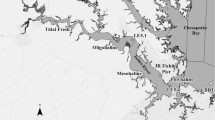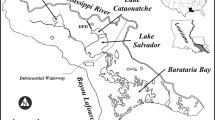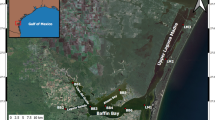Abstract
The Bonnet Carré Spillway, located 28 miles northwest of New Orleans, was constructed in the early 1930s as part of an integrated flood-control system for the lower Mississippi River system. From 11 April to 8 May 2008, Mississippi River water was diverted through the spillway into the 629-square-mile Lake Pontchartrain, which is hydraulically connected to the Gulf of Mexico. On 8 April, prior to the opening of the spillway, water-quality instruments were deployed and recorded hourly measurements of water temperature, dissolved oxygen, specific conductance, pH, and nitrate. Discrete water-quality and phytoplankton (algae) samples were collected in Lake Pontchartrain from 8 April to 3 October 2008 to assess the water-quality nutrient enrichment effects of the diversion on the lake. The maximum influence of river water in the southern portion of the lake was captured with continuous (hourly) monitoring of nitrate concentrations, and field measurements such as of specific conductance during the critical period in late April to early May. By late May, the deployed instruments had recorded the arrival, peak, and decline of selected constituents associated with the freshwater influx from the Mississippi River/Bonnet Carré Spillway diversion. The continuous monitoring data showed the short-term interactions of high-nitrate, low-specific conductance river water and low-nitrate, high-specific conductance lake water. The phytoplankton community composition, as an indicator of water quality, illustrated an extended response from the river water evident even after the continuous and discrete samples indicated that the lake had returned to pre-diversion conditions. The initial phytoplankton community response to nutrient increases was related to accumulations of diatoms. During periods of low nutrient concentrations, accumulations of blue-greens occurred by July and August. As blue-green algae cell densities and biovolumes increased in the summer, so did the species richness of blue-green algae, particularly the harmful algae bloom taxa. Cell densities and biovolume of the phytoplankton lake indicator taxa Skeletonema costatum, Anabaena sp., and Cylindrospermopsis raciborskii were highest and dominated the diatom and blue-green algae communities during the period of most river water influence on the lake and immediately following the freshwater inflows. The dominance and recession of these indictor taxa reflect the dramatic changes that occurred in the phytoplankton community in response to an increase in nutrient-rich freshwater from the diversion into the lake, and not normal seasonal phytoplankton compositional differences. Water-quality data indicated a gradual reversion to pre-diversion lake conditions by June to July, but shifts in the phytoplankton composition were still evident through August 2008. Observations from this study were similar to results from previous studies of Mississippi River/Bonnet Carré Spillway diversion opening in 1997.
Similar content being viewed by others
References
Andrade I, Da Matta, M, Freire H, Garcia R, Pinheiro S, Flynn M (2007) Structure of phytoplankton community along a gradient of salinities in the estuary Cananeia, São Paulo. In: Anais VIII Congr Ecology of Brazil, 23–28 September 2007, Caxambu, Minas Gerais, Brazil
Britton LJ, Greeson PE (1987) Methods for collection and analysis of aquatic biological and microbiological samples. US Geol Surv Tech Water-Resources Investig, pp 139–140
Charles DF, Knowles C, Davis RS (2002) Protocols for the analysis of algal samples collected as part of the U.S. Geological Survey National Water-Quality Assessment Program. Patrick Center for Environmental Research, Academy of Natural Sciences, Philadelphia, PA
Committee on Environment and Natural Resources (2000) National assessment of harmful algal blooms in US waters. National Science and Technology Council Committee on Environment and Natural Resources, Washington, DC
Dortch Q, Peterson T, Turner RE (1998) Algal bloom resulting from the opening of the Bonnet Carré Spillway in 1997. Basics of the Basin Research Symp, 12–13 May. University of New Orleans, New Orleans
Dortch Q, Parson ML, Rabalais NN, Turner RE (1999) What is the threat of harmful algal blooms in Louisiana coastal waters? In: Rozas LP, Nyman JA, Proffitt CE, Rabalais NN, Reed DJ, Turner RE (eds) Recent research in coastal Louisiana. 2–5 February 1998. Louisiana Sea Grant, Lafayette, pp 134–144
Fishman MJ, Friedman LC (1989) Methods for determination of inorganic substances in water and fluvial sediments. US Geol Surv Tech Water-Resources Investig
Garrison CR (1998) Statistical summary of surface-water quality in Louisiana—Mississippi River mainstem, 1905–95. Louisiana Department of Transportation and Development, US Geol Surv Water Resources Tech Rep no 551
Helsel DR, Hirsch RM (1992) Statistical methods in water resources. Elsevier, New York
Kindinger JL, Flocks JG (2000) Geological framework and processes of Lake Pontchartrain, Louisiana. US Geol Surv Water Resources Fact Sheet 025–00
Lane RR, Day JW, Kemp PG, Demcheck DK (2000) The 1994 experimental opening of the Bonnet Carre Spillway to divert Mississippi River water into Lake Pontchartrain, Louisiana. Ecol Eng 17:411–422
Moulton SR II, Kennen JG, Goldstein RM, Hambrook JA (2002) Revised protocols for sampling algal, invertebrate, and fish communities as part of the National Water-Quality Assessment Program. US Geol Surv Open-File Rep 02–150
Mueller DK, Spahr NE (2006) Nutrients in streams and rivers across the nation—1992–2001. US Geol Surv Sci Investig Rep 2006–5107
NASA (2008) Image courtesy of Moderate Resolution Imaging Spectroradiometer (MODIS) Rapid Response Project. National Aeronautics and Space Administration/Goddard Space Flight Center, DIALOG, http://rapidfire.sci.gsfc.nasa.gov/subsets/ (accessed 1 and 13 May 2008)
Ornolfsdottir EB, Lumsden ES, Pinckney JL (2004) Phytoplankton community growth-rate response to nutrient pulses in a shallow turbid estuary, Galveston Bay, Texas. J Plankton Res 3:325–339
Paerl HW, Dyble J, Moisander PH, Nobel RT, Piehler MF, Pinckney JL, Steppe TF, Twomey L, Valdes LM (2003) Microbial indicators of aquatic ecosystem change: current applications to eutrophication studies. Federation of European Microbiological Societies. Microbiol Ecol 46:233–246
Palmer CM (1969) A composite rating of algae tolerating organic pollution. J Phycol 5:78–82
Patton CJ, Truitt EP (2000) Methods of analysis by the U.S. Geological Survey National Water Quality Laboratory—Determination of ammonium plus organic nitrogen by a Kjeldahl digestion method and an automated photometric finish that includes digest cleanup by gas diffusion. US Geol Surv Open-File Rep 00-170
Pinckney JL, Paerl HW, Tester P, Richardson TL (2001) The role of nutrient loading and eutrophication in estuarine ecology. Environ Health Perspectives 109:699–706
Poirrer MA, King JM (1998) Observations on Lake Pontchartrain blue-green algae blooms and fish kills. Basics of the Basin Research Symp, 12–13 May. University of New Orleans, New Orleans
Porter SD, Cuffney TF, Gurtz ME, Meador MR (1993) Methods for collecting algal samples as part of the National Water-Quality Assessment Program. US Geol Surv Open-File Rep 93–409
Rabalais NN, Wiseman WJ, Turner RE, SenGupta BK, Dortch Q (1996) Nutrient changes in the Mississippi River and responses on the adjacent continental shelf. Estuaries 19:386–407
Sandstrom MW, Wydoski DS, Schroeder MP, Zamboni JL, Foreman WT (1992) Methods of analysis by the U.S. Geological Survey National Water Quality Laboratory—Determination of organonitrogen herbicides in water by solid-phase extraction and capillary-column gas chromatography/mass spectrometry with selected-ion monitoring. US Geol Surv Open-File Rep 91–519
Tsuruta A, Ueno S, Ohgai M, Yamada M (1987) Seasonal and horizontal distributions of phytoplanktonic diatom Skeletonema costatum (Grev.) Cleve in Yatsushiro Sea. Bull Japan Soc Sci Fish 53:141–144
Turner RE (1999) Nitrogen losses in water flowing through Louisiana swamps. In: Rozas LP, Nyman JA, Proffitt CE, Rabalais NN, Reed DJ, Turner RE (eds) Recent research in coastal Louisiana. 2–5 February 1998. Louisiana Sea Grant Publ, Lafayette, pp 145–154
Turner RE, Dortch Q, Justic D, Swenson EM (2003) Nitrogen loading into an urban estuary: Lake Pontchartrain. Hydrobiologia 487:137–152
Turner RE, Dortch Q, Rabalais RR (2004) Inorganic nitrogen transformations at high loading rates in an oligohaline estuary. Biochemistry 68:411–422
US Army Corps of Engineers (2009) Spillway Opening Pace: 2008 vs. 1997. http://www.mvn.usace.army.mil/2008%20operation.asp (accessed 4 June 2009)
US Geological Survey (2001) National field manual for the collection of water-quality data. US Geol Surv Tech Water-Resources Investig, book 9, chaps A1-A9, DIALOG, http://pubs.water.usgs.gov/twri9A (accessed 12 December 2008)
Wagner RJ, Boulger RW Jr, Oblinger CJ, Smith BA (2006) Guidelines and standard procedures for continuous water-quality monitors—Station operation, recomputation, and data reporting. US Geol Surv Tech Methods, DIALOG, http://pubs.water.usgs.gov/tm1d3 (accessed 11 April 2008)
Wershaw RL, Fishman MJ, Grabbe RR, Lowe LE (eds) (1987) Methods for the determination of organic substances in water and fluvial sediments. US Geol Surv Tech Water-Resources Investig, book 5, chap A3
Wilkinson L (1998) Nonparametric statistics. SYSYTAT 8.0 Statistics. SPSS, Chicago, pp 693–714
Wilkinson L, Coward M (1998) Linear models I—Linear regression. In: Wilkinson L (ed) SYSYTAT 8.0 Statistics. SPSS, Chicago, pp 369–400
Author information
Authors and Affiliations
Corresponding author
Electronic supplementary material
Rights and permissions
About this article
Cite this article
Mize, S.V., Demcheck, D.K. Water quality and phytoplankton communities in Lake Pontchartrain during and after the Bonnet Carré Spillway opening, April to October 2008, in Louisiana, USA. Geo-Mar Lett 29, 431–440 (2009). https://doi.org/10.1007/s00367-009-0157-3
Received:
Accepted:
Published:
Issue Date:
DOI: https://doi.org/10.1007/s00367-009-0157-3




